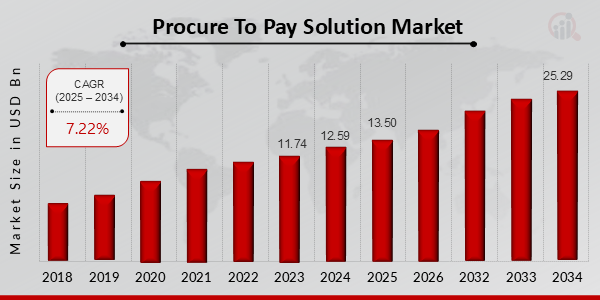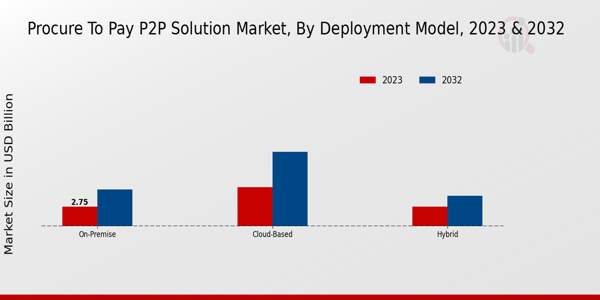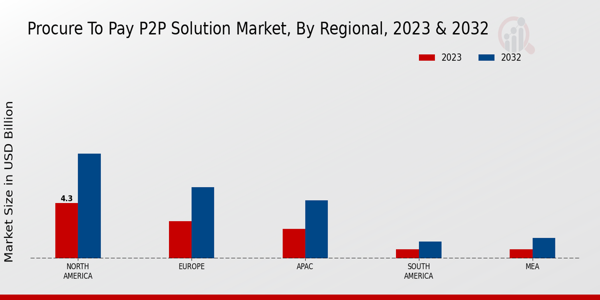Procure to Pay P2P Solution Market Overview
Procure To Pay Solution Market is projected to grow from USD 13.50 Billion in 2025 to USD 25.29 Billion by 2034, exhibiting a compound annual growth rate (CAGR) of 7.22% during the forecast period (2025 - 2034).
Additionally, the market size for Procure To Pay Solution Market was valued at USD 12.59 billion in 2024.
Key Procure to Pay P2P Solution Market Trends Highlighted
The Procure to Pay (P2P) Solution Market is experiencing significant growth due to multiple market drivers pushing organizations toward automation and efficiency. The increasing need for businesses to streamline their operations and reduce costs is a primary catalyst for adopting P2P solutions. Organizations are recognizing the importance of integrating procurement with accounts payable, leading to better visibility and control over their spending. Additionally, the rise of digital technologies and cloud-based solutions has made it easier for companies to implement P2P systems, thereby enhancing collaboration among various departments. There are several opportunities to be explored within this market, especially in small and medium-sized enterprises that are still reliant on manual processes.As these businesses seek to enhance their operational efficiency, they represent a growing segment looking for affordable and easy-to-implement P2P solutions. Furthermore, there is room for innovation in terms of incorporating artificial intelligence and machine learning into P2P processes to further automate tasks and improve decision-making.
This creates a promise for continuous improvement in procurement strategies across various industries. Trends in recent times indicate a shift towards more robust analytics capabilities within P2P solutions. Businesses are increasingly focused on leveraging data to gain insights into their purchasing patterns and supplier performance.Moreover, sustainability has become a crucial factor, with companies wanting to ensure that their suppliers align with their environmental goals. The rise of mobile access to P2P systems also reflects the demand for flexibility and real-time updates, allowing teams to engage with procurement processes from anywhere. These trends illustrate how the P2P landscape continues to evolve, driven by technological advancements and changing business priorities.
Figure 1: Procure to Pay P2P Solution Market size 2025-2034

Source: Primary Research, Secondary Research, MRFR Database and Analyst Review
Procure to Pay P2P Solution Market Drivers
Increasing Demand for Automation in Business Processes
The Procure to Pay P2P Solution Market Industry is witnessing a significant shift towards automation as organizations seek to enhance operational efficiency and reduce manual errors. The rise in demand for automated solutions stems from the necessity for businesses to streamline their procurement and payment processes. By automating these critical functions, companies can not only improve accuracy but also accelerate transaction times. This has become increasingly important as organizations deal with growing transaction volumes, and the push to digitize operations across various sectors continues.Automated Procure to Pay systems help in optimizing procurement activities, managing supplier relationships effectively, and facilitating quicker invoice processing and approval workflows. Moreover, automation enables real-time visibility into spending analysis and budgeting, allowing businesses to make more informed decisions. As organizations progressively adopt these solutions, the Procure to Pay P2P Solution Market is expected to experience robust growth in the upcoming years, reflecting a shift towards smarter business practices that embrace efficiency, accuracy, and speed.
Growing Emphasis on Cost Reduction and Efficiency
One of the key drivers of the Procure to Pay P2P Solution Market Industry is the increasing focus on cost reduction and improving operational efficiency within organizations. Companies are continuously seeking ways to optimize their spend management processes to enhance profitability. The implementation of advanced P2P solutions allows organizations to engage in better negotiations with suppliers, leverage bulk purchasing, and minimize procurement costs.Additionally, these solutions provide insights into spending behavior, enabling businesses to identify savings opportunities and prioritize strategic spending. With economic uncertainties and the need for businesses to be agile, the drive for cost-effectiveness through optimized procurement processes is a significant contributor to market growth.
Rising Adoption of Cloud-Based Solutions
Another prominent driver for the Procure to Pay P2P Solution Market Industry is the rising adoption of cloud-based solutions among organizations. Businesses are increasingly moving their procurement and financial processes to cloud platforms to benefit from enhanced collaboration, flexibility, and scalability. Cloud-based P2P solutions enable organizations to access their procurement data remotely, streamline operations, and integrate with other enterprise applications seamlessly.This transition to cloud environments not only reduces infrastructure costs but also ensures that organizations can keep pace with the rapidly changing technological landscape. The ability to access real-time data and analytics supports better decision-making and enhances organizations' overall agility.
Procure to Pay P2P Solution Market Segment Insights
Procure to Pay P2P Solution Market Deployment Model Insights
The Procure to Pay P2P Solution Market, valued at approximately 10.96 USD Billion in 2023, is characterized by a variety of deployment models that cater to the diverse needs of organizations. Within this market, the deployment model segment is crucial as it allows businesses to choose between different approaches that best suit their operational frameworks. The On-Premise model, valued at 2.75 USD Billion in 2023, holds a significant share but reflects a traditional approach that requires considerable upfront investment in infrastructure.This model may appeal to organizations that prioritize data security and have the resources to manage their IT systems internally. Conversely, the Cloud-based deployment model leads the market with a valuation of 5.5 USD Billion in 2023, showcasing a growing trend towards flexibility and cost-effectiveness. This model enables organizations to leverage scalable solutions without the burdens of physical infrastructure, thereby commanding a considerable advantage in today’s digital business environment.
Furthermore, the Hybrid model, valued at 2.71 USD Billion in the same year, offers a balance between the On-Premise and Cloud-based solutions, providing organizations with the option to maintain certain processes on-site while utilizing cloud capabilities for others.This model is particularly attractive for companies that wish to transition gradually to cloud solutions without completely abandoning their existing systems. The market is expected to experience robust growth across all deployment models, driven by the increasing digital transformation across sectors, the need for integrated processes for better transparency, and the demand for efficient procurement practices. However, challenges such as data security concerns in the Cloud-based model and the ongoing costs associated with On-Premise deployments continue to influence the decision-making processes of organizations. Overall, the deployment model segment within the Procure to Pay P2P Solution Market illustrates a dynamic landscape where organizations are increasingly prioritizing flexibility, efficiency, and integration of their procurement processes to stay competitive while aligning with market trends.

Source: Primary Research, Secondary Research, MRFR Database and Analyst Review
Procure to Pay P2P Solution Market Component Insights
The Procure to Pay P2P Solution Market is expected to reach a valuation of 10.96 billion USD in 2023, reflecting robust growth in the components that significantly drive efficiency in business operations. The component segment comprises Software, Services, and Consulting, with each element playing a crucial role in the overall market dynamics. Software solutions are increasingly vital as organizations seek to automate procurement processes, enhancing productivity and accuracy. Services, including implementation and maintenance, support the seamless integration of P2P systems, while Consulting offers strategic insights that can lead to significant cost savings and improved decision-making.The market is characterized by a consistent trend toward digital transformation and enhanced supply chain visibility, which are key growth drivers shaping the industry's future. The Procure to Pay P2P Solution Market data reveals that as businesses adapt to evolving technological landscapes, the demand for comprehensive solutions continues to rise. Nevertheless, challenges related to interoperability and data security persist, presenting opportunities for innovation and adaptation within this dynamic industry. Overall, the Procure to Pay P2P Solution Market statistics indicate a promising trajectory with ample potential for all components involved.
Procure to Pay P2P Solution Market Business Size Insights
The Procure to Pay P2P Solution Market is expected to be valued at 10.96 USD billion in 2023, reflecting its importance across different business sizes. The market showcases a clear segmentation based on business size, comprising Small Enterprises, Medium Enterprises, and Large Enterprises, each playing a crucial role in the overall market dynamics. Small Enterprises are increasingly recognizing the value of automation in streamlining procurement and payments, leading to a noticeable shift in their adoption of P2P solutions. Medium Enterprises, on the other hand, leverage these solutions to enhance operational efficiency and manage cash flow more effectively, while Large Enterprises dominate the market by utilizing advanced P2P systems integrated with sophisticated analytics for better decision-making.The growth within this sector is driven by the ongoing need for efficiency and cost management, coupled with the digital transformation initiatives that businesses are undertaking. However, challenges such as integration complexities and varying budget constraints hinder some players, which creates opportunities for tailored solutions that cater to specific business needs. The interplay between these different business sizes provides valuable insights into the broader Procure to Pay P2P Solution Market revenue trends and growth potential.
Procure to Pay P2P Solution Market End User Industry Insights
The Procure to Pay P2P Solution Market, valued at 10.96 USD Billion in 2023, showcases a diverse End User Industry landscape. Across various sectors, the platform's adoption is driven by the need for improved operational efficiency and cost management. In Manufacturing, companies leverage these solutions to streamline procurement processes, enhancing supply chain management. Meanwhile, the Retail sector benefits significantly from automation in purchasing, ensuring better inventory control and responsive customer service. The Healthcare industry heavily relies on these solutions to facilitate timely procurement of essential supplies, reducing operational risks.Information Technology emphasizes the importance of integrated P2P systems for better collaboration and data management. Government entities also adopt these solutions for enhanced transparency and compliance in public spending. The overall trends point towards a shift towards digitalization and automation, which are pivotal in driving the market growth in this sector. As the Procure to Pay P2P Solution Market data suggests, the increasing embrace of cloud-based solutions across these industries presents substantial opportunities, though challenges regarding integration and data security remain areas of focus for stakeholders.
Procure to Pay P2P Solution Market Regional Insights
The Procure to Pay P2P Solution Market, valued at 10.96 USD Billion in 2023, demonstrates a robust segmentation across various regional markets. North America holds a majority share, valued at 4.3 USD Billion in 2023, affirming its dominance due to advanced technology adoption and a mature business ecosystem. Europe follows, with a valuation of 2.9 USD Billion, reflecting significant investment in automation and digital transformation. The APAC region, valued at 2.3 USD Billion, is emerging rapidly, driven by increasing digitalization in emerging economies and a growing emphasis on cost-effective solutions.South America and MEA both present smaller market sizes, valued at 0.7 USD Billion, but are anticipated to grow, with MEA showcasing a notable CAGR owing to improving economic conditions and infrastructure development. This diverse Procure to Pay P2P Solution Market data illustrates varying regional growth dynamics influenced by technological advancements and market demands.

Source: Primary Research, Secondary Research, MRFR Database and Analyst Review
Procure to Pay P2P Solution Market Key Players and Competitive Insights:
The competitive insights of the Procure to Pay P2P Solution Market reveal a dynamic landscape characterized by rapid technological advancements and a significant shift toward digital transformation within organizations. Companies in this market are competing to deliver comprehensive solutions that streamline purchasing and payment processes, thereby improving operational efficiency and enhancing supplier relationships. The increasing demand for automation and integration with existing enterprise systems is driving innovation among key players. A focus on real-time data analytics and user-friendly interfaces is essential as organizations seek to optimize their procurement cycles and minimize costs. The competitive environment is shaped by factors like market share, product functionalities, customer service, and the ability to adapt to evolving customer needs, thereby influencing strategic decisions.Oracle stands out in the Procure to Pay P2P Solution Market due to its robust cloud-based offerings and comprehensive suite of applications that cater to diverse procurement needs across different industries.
Oracle has built a strong market presence through its commitment to innovation, enabling organizations to manage their procurement processes effectively. One of its key strengths lies in its extensive ecosystem that integrates procurement with other enterprise functions, such as finance and supply chain management, providing a unified platform for enhanced visibility and control. The advanced analytics and reporting capabilities offered by Oracle empower businesses to make informed decisions while optimizing their spend management. Oracle’s strong focus on customer success and support ensures that organizations can leverage its solutions to drive efficiencies and achieve strategic procurement objectives.Tradeshift also plays a significant role in the Procure to Pay P2P Solution Market, specializing in supply chain payments and collaboration solutions that empower businesses to streamline their procurement processes.
Tradeshift has established a strong value proposition with its user-friendly interface and an emphasis on facilitating seamless communication between buyers and suppliers. The company stands out for its innovative approach to enabling real-time transaction visibility and accelerating invoice processing, which enhances cash flow management for organizations. Tradeshift’s strengths include its extensive digital network that allows companies to connect with a diverse array of suppliers, helping enterprises optimize their supply chain quickly and effectively. The platform’s adaptability to different procurement needs showcases its capabilities in fostering collaborative relationships, thereby contributing to a more efficient and transparent procurement environment.
Key Companies in the Procure to Pay P2P Solution Market Include
-
Oracle
-
Tradeshift
-
Proactis
-
SynerTrade
-
Infor
-
Basware
-
Ariba
-
Jaggaer
-
Coupa
-
Zoho
-
GEP
-
Wolters Kluwer
-
Elastic Cloud Solutions
-
SAP
-
Ivalua
Procure to Pay P2P Solution Market Industry Developments
The Procure to Pay (P2P) Solution Market has witnessed significant developments recently. Oracle has been enhancing its P2P capabilities, aiming to streamline procurement processes for businesses. Tradeshift continues to expand its platform, focusing on improving supplier collaboration and automated processes. Proactis has been active in acquiring smaller tech firms to bolster its P2P offerings, highlighting a trend of consolidation in the market. SynerTrade is also innovating with AI-driven solutions to optimize procurement operations. Infor and Basware are making strides in integrating sustainability into their P2P solutions. Coupa has reported strong financial growth, demonstrating a robust demand for its P2P services, while SAP maintains its leadership position by continuously upgrading its product features. Recent acquisition news includes Jaggaer acquiring new technology startups to enhance its supply chain visibility, which aligns with current market trends toward digital transformation. GEP's growth is driven by its investments in cloud-based P2P solutions. Moreover, the market valuation for these companies is expanding, thanks in part to increasing demand for automation and efficiency in procurement processes, positively influencing overall market dynamics.
Procure to Pay P2P Solution Market Segmentation Insights
-
Procure to Pay P2P Solution Market Deployment Model Outlook
-
On-Premise
-
Cloud-based
-
Hybrid
-
Procure to Pay P2P Solution Market Component Outlook
-
Software
-
Services
-
Consulting
-
Procure to Pay P2P Solution Market Business Size Outlook
-
Small Enterprises
-
Medium Enterprises
-
Large Enterprises
-
Procure to Pay P2P Solution Market End User Industry Outlook
-
Manufacturing
-
Retail
-
Healthcare
-
Information Technology
-
Government
-
Procure to Pay P2P Solution Market Regional Outlook
-
North America
-
Europe
-
South America
-
Asia Pacific
-
Middle East and Africa
Procure to Pay P2P Solution Market Report Scope
|
Report Attribute/Metric
|
Details
|
|
Market Size 2024
|
12.59 (USD Billion)
|
|
Market Size 2025
|
13.50 (USD Billion)
|
|
Market Size 2034
|
25.29 (USD Billion)
|
|
Compound Annual Growth Rate (CAGR)
|
7.22% (2025 - 2034)
|
|
Report Coverage
|
Revenue Forecast, Competitive Landscape, Growth Factors, and Trends
|
|
Base Year
|
2024
|
|
Market Forecast Period
|
2025 - 2034
|
|
Historical Data
|
2019 - 2023
|
|
Market Forecast Units
|
USD Billion
|
| Key Companies Profiled |
Oracle, Tradeshift, Proactis, SynerTrade, Infor, Basware, Ariba, Jaggaer, Coupa, Zoho, GEP, Wolters Kluwer, Elastic Cloud Solutions, SAP, Ivalua |
| Segments Covered |
Deployment Model, Component, Business Size, End User Industry, Regional |
| Key Market Opportunities |
Cloud-based solutions adoption, Integration with AI technologies, Increased demand for automation, Rising focus on cost reduction, Expansion in emerging markets |
| Key Market Dynamics |
Digital transformation in procurement, Increasing demand for cost efficiency, Rise in automation and AI, Enhanced supplier collaboration, Growing focus on compliance and risk management. |
| Countries Covered |
North America, Europe, APAC, South America, MEA |
Frequently Asked Questions (FAQ) :
The Procure to Pay P2P Solution Market is expected to reach a value of 25.29 USD Billion by 2034
The CAGR for the Procure to Pay P2P Solution Market is projected to be 7.2% from 2025 to 2034
North America is anticipated to hold the largest market share with a projected value of 8.1 USD Billion by 2032.
The Cloud-based deployment model segment is expected to be valued at 10.5 USD Billion by 2032.
Major players in the market include Oracle, Tradeshift, Coupa, SAP, and Basware among others.
The APAC region is projected to reach a market size of 4.5 USD Billion by 2032.
The On-Premise deployment model segment is expected to be valued at 5.2 USD Billion by 2032.
Increased automation and digital transformation in procurement processes are key growth drivers for the market.
The South American region is anticipated to have a market value of 1.3 USD Billion by 2032.
Challenges include managing procurement complexity and integrating new technologies within existing systems.
















